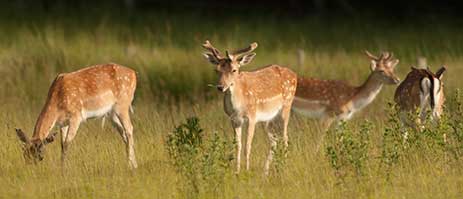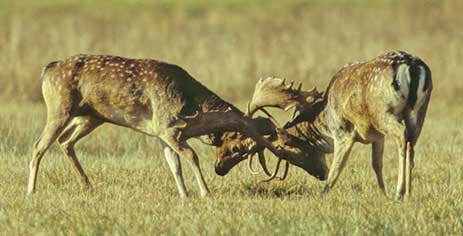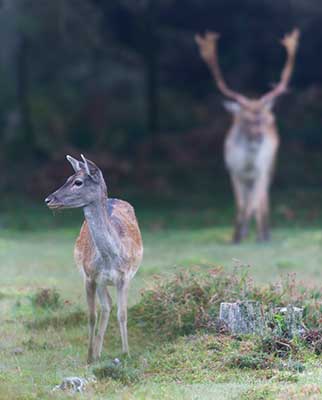New Forest Fallow deer - identification and behaviour
How many: The most abundant and widespread New Forest deer - 1200 to 1400 fallow deer are present.
Herds: Typically, in medium sized, single sex herds. Does are joined by bucks in late summer and during the subsequent rut.
Size: Up to 76-91 centimetres (30-36 inches) at the shoulder, bucks larger than does.
Coat: In late-spring and summer, typically chestnut coloured with pale spots. At other times, dark brown above, pale below. A number of variations occur. Boldly marked menil deer, for example, stay in a summer-like coat all the year round, whilst very dark animals also occur. Others are very pale.
Rear end: Dark, broad line down a long tail. Pale caudal, rump patch, edged with black.
Antlers: Well grown antlers are long, broad, flat / palmate
Sounds: Fallow deer throughout the year use a cough-like bark. During the rut, bucks use a deep, belching groan.
Fallow deer - the annual rut

The fallow deer rut, the mating season, is an exciting time for deer and deer watcher alike.
Starting in early October, the fallow deer rut lasts for 3-4 weeks, although bucks’ rutting physique starts to develop considerably earlier - velvet, the layer of initially soft, hairy skin that covers the growing antlers, dies back and is rubbed off; the bone hardens ready for the battles ahead; Adam’s apples begin to bulge; bulk increases, particularly around the neck and shoulders; and rutting odours develop.
In early September, fallow bucks re-appear in traditional rutting areas, having spent the preceding months in bachelor parties, separate from the does. The bucks remain for a while in each others company, but increasingly prepare for action. Play fights develop; rutting postures are intermittently assumed; vegetation is thrashed; antlers become burnished; and scrapes and wallows are made in which the bucks churn the ground, urinate in the quagmire and roll in the resultant mess - it apparently makes them more attractive to the ladies!
Fallow deer woodland rutting stands are often quite small, with sometimes hardly room for buck and a couple of does. Some rutting stands, though, are extensive expanses of ground, muddied by constant stamping and overhung by shredded branches.
Throughout the rut, thrashing of branches continues, and so does stamping and parading. But in quieter, maybe more lucid, moments, bucks stretch up their bulky necks, reach high to seemingly caress the tattered branches, but in the process deposit scent from a gland below the eye, marking their territory so that others will know it is occupied.

Groaning - the fallow buck’s mating call – is perhaps best described as a cross between a loud belch, a groan, a snore, a snort and a growl. It is used to attract the does for, unlike red deer stags, fallow bucks generally do not actively round-up and maintain a harem. They depend for courtship success upon the attractions of their groan!
With head held not much above the horizontal, lips curled back and pursed, the primeval sound seems to come from deep within the animal's very being.
But it’s not only does that are attracted by the commotion, for often other inquisitive bucks, both young and old, come to investigate – it’s as if the groans advertise the proximity of a group of does, which often, of course, they do.
Noise and posturing is often enough to settle disputes, but when rival bucks are reasonably evenly matched and equally belligerent, battle royals occur. Then the woods reverberate to the sound of bone striking bone as fights commence. But combatants don’t just stand head-to-head, trading blows – these contests are really battles of strength as, heads down, antlers locked, the deer push and shove, using every straining muscle to gain advantage.

Eventually, the vanquished buck will break off from battle, turn and run, usually pursued by the victor, keen to drive home his advantage. But sometimes antlers become inextricably locked together, and it’s not so easy to escape. Then, unable to feed or fend for themselves, the animals face a sad, slow, lingering death in uncomfortably close proximity to each other.
Serious injuries quite often occur – this is not simply a ritual form of fighting. Eyes are lost to gouging antlers, flanks are slashed and animals lamed in frenzies of naked aggression.
Yearling bucks are often tolerated around the stand, provided that they stay at the edge where often they’ll feed, skirmish amongst themselves or simply lie up. Any that move in too close, though, will be noisily chased away.
Fallow does often ignore the fighters, or look on, seemingly perplexed, before, maybe sick-and-tired of the whole noisy process, they quietly wander off.
Rutting activity generally quietens by mid-morning. Then the resident buck will likely sit down in the midst of the stand, whilst does and younger bucks settle around the edge, or feed nearby.
For the bucks, the rut is an incredibly tiring time. By the end of the process, they’re likely to have lost considerable weight and be exhausted, ready to slip into the background where they blend well with the leaves and bracken whilst trying to regain condition before the onset of winter.
Then, of course, it’s time for the bachelor parties to form, and the annual cycle starts afresh.
New Forest deer - find out lots more
References:
The History of British Mammals: Derek Yalden
Deer Watch: Richard Prior
New Forest Roe deer: John K. Fawcett
Roe deer: John K. Fawcett
Sika deer: Rory Putman
Fallow deer: Jochen Langbein and Norma Chapman
More links
Other related links
Search this site

Sadly, 58 animals were killed - 35 ponies, 13 cows, 8 donkeys and 2 sheep, whilst a further 32 were injured - 3 pigs, 9 donkeys, 11 cows and 9 ponies.
(Forty-three accidents occurred in daylight, 15 at twilight and 101 in the dark. Twenty-seven accidents were not reported by the driver involved).
Here's just one horrific example - Three donkeys killed in collision with van at notorious New Forest blackspot (Advertiser and Times)

